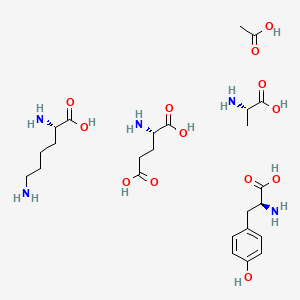



1. 5010, Tv
2. Acetate, Glatiramer
3. Copaxone
4. Glatiramer
5. Tv 5010
6. Tv-5010
7. Tv5010
1. 147245-92-9
2. Acetic Acid;(2s)-2-amino-3-(4-hydroxyphenyl)propanoic Acid;(2s)-2-aminopentanedioic Acid;(2s)-2-aminopropanoic Acid;(2s)-2,6-diaminohexanoic Acid
3. Glatirameracetat
4. Dtxsid30163637
5. Am84438
6. Ac-28732
7. L-alanine Compound With L-glutamic Acid And L-lysine And L-tyrosine And Acetic Acid (1:1:1:1:1)
8. Q418274
1. Glat Copolymer
2. Tgal Copolymer
3. Synthetic Peptide Copolymer I
4. Glatiramer
| Molecular Weight | 623.7 g/mol |
|---|---|
| Molecular Formula | C25H45N5O13 |
| Hydrogen Bond Donor Count | 12 |
| Hydrogen Bond Acceptor Count | 18 |
| Rotatable Bond Count | 13 |
| Exact Mass | 623.30138651 g/mol |
| Monoisotopic Mass | 623.30138651 g/mol |
| Topological Polar Surface Area | 374 Ų |
| Heavy Atom Count | 43 |
| Formal Charge | 0 |
| Complexity | 519 |
| Isotope Atom Count | 0 |
| Defined Atom Stereocenter Count | 4 |
| Undefined Atom Stereocenter Count | 0 |
| Defined Bond Stereocenter Count | 0 |
| Undefined Bond Stereocenter Count | 0 |
| Covalently Bonded Unit Count | 5 |
| 1 of 2 | |
|---|---|
| Drug Name | Copaxone |
| PubMed Health | Glatiramer (Injection) |
| Drug Classes | Central Nervous System Agent, Immune Suppressant, Musculoskeletal Agent |
| Drug Label | Glatiramer acetate, the active ingredient of COPAXONE, consists of the acetate salts of synthetic polypeptides, containing four naturally occurring amino acids: L-glutamic acid, L-alanine, L-tyrosine, and L-lysine with an average molar fraction of 0.... |
| Active Ingredient | Glatiramer acetate |
| Dosage Form | Injectable |
| Route | Subcutaneous |
| Strength | 20mg/ml; 40mg/ml |
| Market Status | Prescription |
| Company | Teva Pharms Usa |
| 2 of 2 | |
|---|---|
| Drug Name | Copaxone |
| PubMed Health | Glatiramer (Injection) |
| Drug Classes | Central Nervous System Agent, Immune Suppressant, Musculoskeletal Agent |
| Drug Label | Glatiramer acetate, the active ingredient of COPAXONE, consists of the acetate salts of synthetic polypeptides, containing four naturally occurring amino acids: L-glutamic acid, L-alanine, L-tyrosine, and L-lysine with an average molar fraction of 0.... |
| Active Ingredient | Glatiramer acetate |
| Dosage Form | Injectable |
| Route | Subcutaneous |
| Strength | 20mg/ml; 40mg/ml |
| Market Status | Prescription |
| Company | Teva Pharms Usa |
Antirheumatic Agents
Drugs that are used to treat RHEUMATOID ARTHRITIS. (See all compounds classified as Antirheumatic Agents.)
Immunosuppressive Agents
Agents that suppress immune function by one of several mechanisms of action. Classical cytotoxic immunosuppressants act by inhibiting DNA synthesis. Others may act through activation of T-CELLS or by inhibiting the activation of HELPER CELLS. While immunosuppression has been brought about in the past primarily to prevent rejection of transplanted organs, new applications involving mediation of the effects of INTERLEUKINS and other CYTOKINES are emerging. (See all compounds classified as Immunosuppressive Agents.)
Adjuvants, Immunologic
Substances that augment, stimulate, activate, potentiate, or modulate the immune response at either the cellular or humoral level. The classical agents (Freund's adjuvant, BCG, Corynebacterium parvum, et al.) contain bacterial antigens. Some are endogenous (e.g., histamine, interferon, transfer factor, tuftsin, interleukin-1). Their mode of action is either non-specific, resulting in increased immune responsiveness to a wide variety of antigens, or antigen-specific, i.e., affecting a restricted type of immune response to a narrow group of antigens. The therapeutic efficacy of many biological response modifiers is related to their antigen-specific immunoadjuvanticity. (See all compounds classified as Adjuvants, Immunologic.)
L03AX13
S76 | LUXPHARMA | Pharmaceuticals Marketed in Luxembourg | Pharmaceuticals marketed in Luxembourg, as published by d'Gesondheetskeess (CNS, la caisse nationale de sante, www.cns.lu), mapped by name to structures using CompTox by R. Singh et al. (in prep.). List downloaded from https://cns.public.lu/en/legislations/textes-coordonnes/liste-med-comm.html. Dataset DOI:10.5281/zenodo.4587355
L - Antineoplastic and immunomodulating agents
L03 - Immunostimulants
L03A - Immunostimulants
L03AX - Other immunostimulants
L03AX13 - Glatiramer acetate